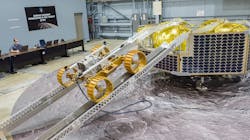EAST AURORA, N.Y., - Moog Inc. announced that the company’s space products have been selected for an upcoming NASA mission to explore the Moon’s South Pole. The Volatiles Investigating Polar Exploration Rover, or VIPER, is NASA’s first mobile robotic rover mission to the Moon.
VIPER will rely on Moog’s radiation-hardened avionics technology to control the rover during its 100-day mission. The Integrated Avionics Unit (IAU) and Spacecraft Energization and Power Interfacing Assembly (SEPIA) will be the main computer and power management source for VIPER, essentially the “brains” of the rover.
Moog’s IAU combines traditional command and data handling and electric power subsystem functions. The IAU controls VIPER’s instruments for command, telemetry, heaters, and temperature/voltage/current sensors. In addition, the Moog equipment provides radiation-tolerant image processing and storage that will guide VIPER’s maneuvers across the lunar surface. The IAU and SEPIA will also manage the solar array, battery charging, and power distribution that support the large power requirements needed for wheel motor control and drilling capabilities. A particularly unique capability of the Moog equipment is the very low-power hibernation mode that will allow VIPER to survive the challenging prolonged lunar nights throughout the mission.
VIPER represents the first resource mapping mission on another celestial body. It will determine the concentration of water and ice that could eventually be harvested to sustain human exploration. This data will be instrumental in determining possible future landing sites for the NASA Artemis program, which will return Americans to the moon.
VIPER is set to land on the lunar surface in late 2023 under NASA’s Commercial Lunar Payload Services (CLPS) program. VIPER will be the largest and heaviest payload delivered by a CLPS provider.

